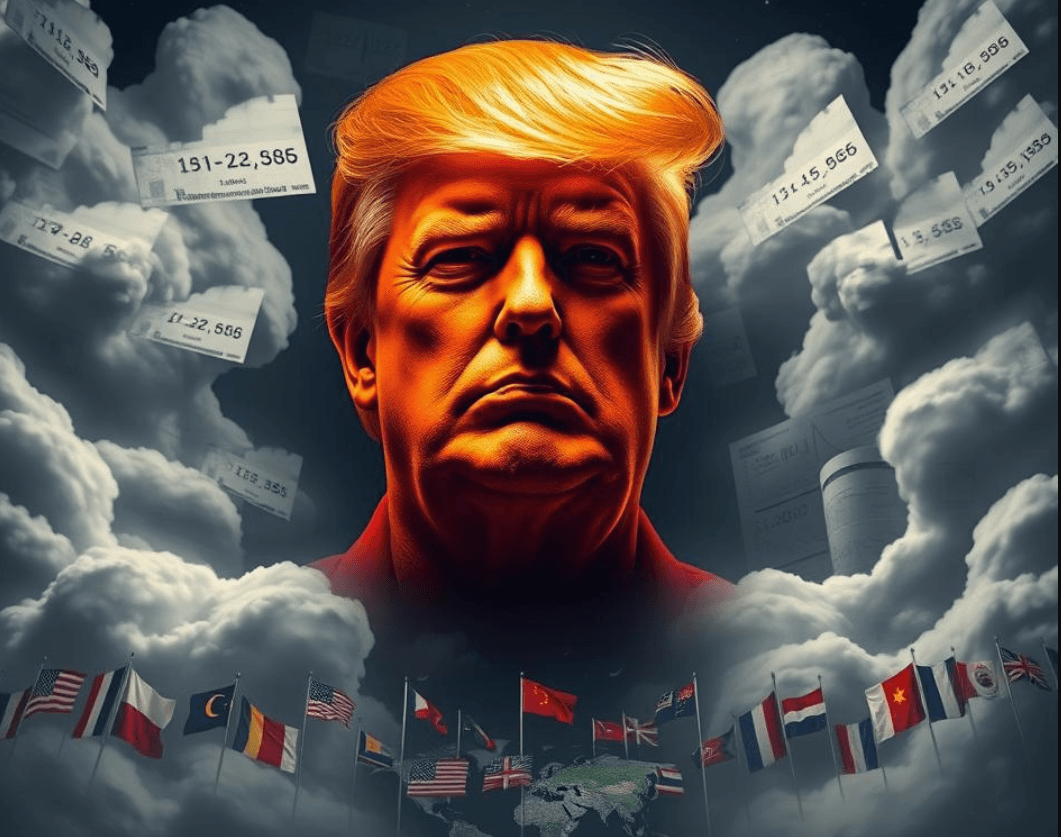Table of Contents
Trade policies have always played a crucial role in shaping global economies. Recently, President Donald Trump announced a significant shift in U.S. trade strategy. During a Rose Garden event, he introduced a new policy aimed at addressing the $1.2 trillion trade imbalance.
This policy includes a 10% baseline tariff on all imports, with discounted rates for certain nations. It marks the largest trade intervention since World War II. The goal is to create a fairer system for American businesses and workers.

The announcement immediately impacted the markets. The S&P 500 fell by 2.47%, and the Nasdaq dropped 3.45%. These reactions highlight the policy’s potential to reshape global trade dynamics.
We’ll explore how this approach differs from traditional measures and its phased implementation. Understanding these changes is essential for businesses and consumers alike.
Understanding Reciprocal Tariffs
The White House has introduced a groundbreaking approach to address trade imbalances. This policy uses a deficit-based formula to calculate import duties, aiming to create a fairer system for American businesses. Unlike traditional measures, this method focuses on balancing trade relationships with other nations.
Definition and Historical Context
Reciprocal tariffs are calculated using a specific formula: (Trade deficit ÷ Imports) ÷ 2 = Reciprocal rate. This approach differs from the Most Favored Nation (MFN) structure, which applies uniform rates to all trading partners. Historically, the Smoot-Hawley tariffs of 1930 serve as a cautionary example of how protectionist policies can escalate trade tensions.

Non-tariff barriers, such as regulations and subsidies, also play a role in these calculations. For instance, technical barriers and intellectual property protections can influence the final rates. Strategic partners like Australia and Brazil receive exceptions, reflecting their importance to U.S. trade.
How Reciprocal Tariffs Differ from Standard Tariffs
Traditional tariffs are often fixed and apply uniformly across countries. In contrast, reciprocal tariffs are dynamic, adjusting based on trade deficits. This means countries with larger deficits face higher rates. For example, 65 nations currently face rates above the baseline 10%, while the UK maintains a 10% rate despite its trade surplus.
The White House justifies this approach as a way to protect national interests. By halving the calculated rates, the policy aims to be “kind” while still addressing imbalances. This nuanced strategy highlights the complexities of modern trade policies.
| Country | Trade Deficit (in billions) | Reciprocal Rate |
|---|---|---|
| China | $350 | 15% |
| Germany | $75 | 12% |
| Australia | $10 | 5% |
For more details on how these tariffs are implemented, visit the White House’s official policy page.
How Reciprocal Tariffs Are Calculated
Calculating tariffs involves a specific formula based on trade deficits. The White House uses a deficit-based approach to determine import duties. This method aims to address imbalances and create a fairer system for U.S. businesses.

The White House’s Formula Explained
The formula is straightforward: (Trade deficit ÷ Imports) ÷ 2 = Reciprocal rate. For example, China’s rate is calculated as ($295B deficit ÷ $440B imports) ÷ 2, resulting in a 34% rate. Similarly, the EU’s rate is derived from a $235B deficit and $490B in imports.
The Council of Economic Advisers plays a key role in these calculations. They ensure the rates reflect accurate data from the U.S. Bureau of Economic Analysis. However, the formula has limitations. It ignores services trade and currency valuations, which can skew results.
Trade Deficits as a Key Factor
Trade deficits are central to determining rates. Countries with larger deficits face higher tariffs. For instance, Vietnam’s $123B deficit leads to a surprising 46% rate. On the other hand, the UK and Australia maintain the baseline 10% rate despite their trade surpluses.
Cambodia’s 97% rate reflects its $9B deficit relative to $9.3B in imports. This extreme example highlights how the formula works in practice. The White House also considers a “cheating” factor, though it hasn’t quantified this yet.
| Country | Trade Deficit (in billions) | Reciprocal Rate |
|---|---|---|
| China | $295 | 34% |
| EU | $235 | 24% |
| Vietnam | $123 | 46% |
Trump’s Sweeping Reciprocal Tariff Policy
The recent policy shift in U.S. trade strategy has sparked widespread discussion. Announced during a Rose Garden ceremony, the new tariffs aim to address long-standing trade imbalances. A giant chart displayed during the event highlighted the tariff rates for over 180 nations, emphasizing the policy’s global reach.
The “Liberation Day” Announcement
Dubbed “Liberation Day,” the announcement outlined a three-tier rollout. First, a 25% auto tariff took effect on April 3, 2025. This was followed by a baseline 10% rate on all imports. Finally, reciprocal rates were introduced, targeting countries with significant trade deficits.
The White House justified the policy under emergency powers, citing national security concerns. By addressing trade imbalances, the administration aims to protect U.S. industries and workers.
Baseline 10% Tariff and Discounted Rates
While the baseline rate applies to most imports, exceptions exist for 22 surplus countries. These nations receive discounted rates, reflecting their balanced trade relationships with the U.S. For example, Australia and the UK maintain the 10% rate despite their trade surpluses.
Internal documents reveal a comprehensive list of 180 nations, each assigned specific rates. Cambodia, with a 49% rate, stands out as one of the most impacted. Meanwhile, the pharmaceutical industry enjoys a temporary exemption, shielding it from immediate effects.
The automotive sector, however, faces an immediate 25% burden. This move has sparked concerns about potential price increases and market volatility. As the policy unfolds, its long-term implications remain a topic of intense debate.
Countries Facing the Highest Tariffs
The new trade policy has placed certain nations under significant economic pressure. These countries are now dealing with some of the highest tariffs ever imposed by the U.S. This section explores the top 10 most impacted nations and highlights some surprising exceptions.

Top 10 Most Impacted Nations
Several nations are bearing the brunt of the new policy. Lesotho and Saint Pierre top the list with a staggering 50% tariff rate. Close behind are Laos and Cambodia, facing 48% and 49% respectively. Vietnam, a key trade partner, is also heavily impacted with a 46% rate.
Madagascar and Sri Lanka follow with rates of 47% and 44%. Syria, Iraq, and Mauritius round out the top 10 with rates ranging from 39% to 41%. These high rates reflect the U.S. strategy to address significant trade deficits with these nations.
| Country | Tariff Rate |
|---|---|
| Lesotho | 50% |
| Saint Pierre | 50% |
| Laos | 48% |
| Cambodia | 49% |
| Vietnam | 46% |
| Madagascar | 47% |
| Sri Lanka | 44% |
| Syria | 41% |
| Iraq | 39% |
| Mauritius | 40% |
Notable Exceptions and Surprises
While many nations face high tariffs, some exceptions stand out. The UK and Australia, despite their close alliances, maintain the baseline 10% rate. This is due to their balanced trade relationships with the U.S.
Another surprise is Taiwan, which faces a 32% rate compared to China’s 34%. This slight differential highlights the nuanced approach of the policy. Additionally, the Falkland Islands, with an $82M deficit, face a 41% rate, showcasing how even smaller economies are impacted.
For a detailed breakdown of tariff impacts, visit this analysis.
Economic Impact of Reciprocal Tariffs
The U.S. economy is bracing for significant changes due to recent trade adjustments. These measures are expected to reshape industries, influence consumer behavior, and alter global economic dynamics. Let’s explore the projected effects on GDP and the potential rise in consumer prices.

Projected Effects on U.S. GDP
Economists at Yale University predict a 50% reduction in GDP growth for 2025. This alarming projection highlights the potential drag on the economy. High Frequency Economics also forecasts a 10% drop in Q2 GDP, signaling immediate challenges.
The policy’s revenue impact is equally concerning. While it may generate $3 trillion, the extension of a $1.5 trillion tax cut could offset these gains. This imbalance raises questions about long-term economic stability.
Consumer Price Increases
Consumers are likely to feel the pinch as prices rise across key sectors. The Congressional Budget Office (CBO) estimates significant spikes in durable goods, with electronics up 35% and apparel increasing by 28%. These hikes could add the equivalent of 12+ months of inflation to household budgets.
The passthrough effect on domestic manufacturing costs will further strain companies. Agricultural exports, a critical sector, are particularly vulnerable. These changes could signal broader economic challenges, including potential recession indicators like an inverted yield curve.
As the global economy reacts, the IMF has warned of a contraction in growth. This interconnected impact underscores the far-reaching consequences of the new policy. Businesses and consumers must prepare for a shifting economic landscape.
Global Reactions to U.S. Tariffs
Global leaders are responding swiftly to the new U.S. trade measures. These actions have sparked a wave of countermeasures and strategic adjustments across the world. Let’s explore how key regions are adapting to these changes.
European Union’s Response
The EU is considering a 25% retaliatory tariff on U.S. imports. This three-phase plan includes immediate tariffs on agricultural goods, followed by industrial products, and finally, a review of financial services. Poland estimates a 0.4% GDP loss due to these measures.
France has criticized the U.S. approach, calling it an “imperialist posture.” Meanwhile, Germany is working with other EU partners to minimize the impact on their economies. The EU’s unified stance highlights its commitment to protecting its markets.
Asian Economies’ Countermeasures
Asian countries are also taking significant steps. Japan is preparing for currency interventions to stabilize its economy. Vietnam is proposing textile import substitutions to reduce reliance on U.S. goods.
India is renegotiating a $500 billion trade deal with the U.S., seeking more favorable terms. Singapore’s Monetary Authority (MAS) is focusing on currency stabilization to shield its economy. Malaysia, however, has refused to reciprocate, opting for a more neutral stance.
| Country | Response | Impact |
|---|---|---|
| EU | 25% retaliatory tariffs | 0.4% GDP loss (Poland) |
| Japan | Currency intervention | Stabilization efforts |
| Vietnam | Textile substitutions | Reduced reliance on U.S. goods |
| India | $500B trade deal renegotiation | Seeking favorable terms |
| Singapore | MAS currency stabilization | Economic shielding |
| Malaysia | Refusal to reciprocate | Neutral stance |
These reactions underscore the interconnected nature of global trade. As nations adapt, the long-term effects on the world economy remain uncertain.
How Reciprocal Tariffs Affect U.S. Trading Partners
The new trade measures are reshaping relationships with key U.S. trading partners. These changes are creating ripple effects across industries, forcing nations to adapt their strategies. Let’s explore how specific sectors and countries are responding.
China faces a 34% effective rate on its goods, impacting its electronics and manufacturing sectors. This has led to increased costs for U.S. imports of Chinese products. Meanwhile, Thailand’s $55 billion in exports now confronts a 36% barrier, threatening its automotive and textile industries.
Germany’s automotive sector is particularly vulnerable. With a significant share of its production exported to the U.S., the new tariffs could disrupt supply chains. Similarly, Taiwan’s semiconductor industry is exploring alternative markets to mitigate risks.
Brazil is focusing on agricultural diversification, redirecting its exports to other regions. South Korea is renegotiating the KORUS trade agreement to secure more favorable terms. Canada and Mexico, however, remain exempt under the USMCA, shielding them from immediate impacts.
ASEAN nations are realigning their supply chains to reduce dependence on U.S. markets. These adaptations highlight the interconnected nature of global trade and the far-reaching consequences of the new policy.
Trump’s Justification for the Policy
The recent trade measures introduced by President Donald Trump have sparked intense debate and scrutiny. The administration has framed these actions as essential for protecting national security and fulfilling long-standing campaign promises. Let’s explore the key arguments behind this policy.
National Security Argument
The administration has invoked national security as a primary justification. Citing the Title III of the Defense Production Act, they argue that addressing the $1.2 trillion trade deficit is critical to safeguarding the economy. This approach mirrors the 235% steel tariff precedent, which was also justified on security grounds.
Trump’s rhetoric often emphasizes “economic patriotism,” framing the policy as a defense against foreign exploitation. The “looted nation” narrative has been central to this argument, portraying the U.S. as a victim of unfair trade practices.
Campaign Promise Fulfillment
This policy aligns with Trump’s 2016 “America First” platform, which vowed to revitalize U.S. manufacturing. On the 2024 campaign trail, he reiterated this commitment, promising to bring jobs back to American workers. The administration projects that these measures will create over 1 million manufacturing jobs by 2030.
However, the use of emergency powers has drawn bipartisan criticism. Critics argue that such measures set a dangerous precedent, bypassing traditional legislative processes. Despite this, the administration remains steadfast in its approach, viewing it as a necessary step to rectify long-standing imbalances.
| Argument | Details |
|---|---|
| National Security | Invokes Defense Production Act; addresses $1.2T deficit |
| Economic Patriotism | Frames policy as defense against foreign exploitation |
| Campaign Promise | Aligns with “America First” platform; projects 1M+ jobs |
| Criticism | Bipartisan concerns over emergency powers use |
Criticisms from Economists
Economists worldwide are raising concerns about the recent trade measures. Many argue that these policies could harm the economy rather than protect it. For instance, Yale and LSE economists have rebuked the approach, calling it “reverse engineered” and lacking a solid foundation.
JPMorgan has issued warnings about potential stagflation, where rising prices coincide with stagnant economic growth. This scenario could strain both businesses and consumers, leading to long-term challenges.
One major flaw is the exclusion of services trade from the calculations. This oversight ignores a significant portion of the U.S. economy, skewing the results. Additionally, the policy fails to account for agricultural comparative advantage, which could hurt American farmers.
Historical protectionism failures, such as the Smoot-Hawley Act, serve as cautionary examples. These measures often escalate tensions rather than resolve them. Critics also point out blind spots in addressing currency manipulation, which can distort trade balances.
Finally, the policy has drawn criticism for violating WTO rules. This could lead to legal challenges and further complicate global trade relationships. Below is a summary of key critiques from leading economists:
| Economist/Institution | Critique |
|---|---|
| Yale/LSE | Reverse engineered approach lacks foundation |
| JPMorgan | Risks of stagflation |
| IMF | Spending/saving imbalance |
| King’s College London | Deficit analysis flaws |
These critiques highlight the need for a more balanced and comprehensive approach to trade policy. Addressing these concerns could help mitigate potential risks and foster a healthier global economy.
Market Reactions to Tariff Announcements
The announcement of new trade measures sent shockwaves through global markets, triggering immediate reactions across industries. Investors scrambled to adjust their portfolios as uncertainty loomed. The S&P 500 ETF dropped by 2.47%, while the Nasdaq ETF sank 3.45%, reflecting widespread concern.
After-hours trading saw significant chaos, with sharp declines in key sectors. The automotive industry faced a bloodbath, with major companies experiencing steep losses. Tech stocks, already vulnerable, took a hit as investors feared rising costs and disrupted supply chains.
Stock Market Volatility
The initial market reaction was swift and severe. Safe-haven assets like gold and Treasury bonds surged as investors sought stability. Agricultural futures plunged, signaling concerns about export disruptions. Retail companies braced for margin pressures as prices for imported goods rose.
Sector-Specific Impacts
Pharmaceutical companies initially felt relief due to temporary exemptions but later faced uncertainty. The automotive sector, however, was hit hard, with a 25% tariff on imports. BlackRock’s risk assessment warned of prolonged volatility, urging investors to remain cautious.
| Sector | Impact |
|---|---|
| Automotive | 25% tariff on imports; steep losses |
| Tech | Vulnerability due to rising costs |
| Pharmaceuticals | Initial relief, later uncertainty |
| Agriculture | Futures plunge; export concerns |
| Retail | Margin pressures from higher prices |
As the dust settles, the long-term effects on global markets remain uncertain. Investors and companies alike must navigate this new landscape with caution and adaptability.
Reciprocal Tariffs and the Auto Industry
The auto industry is facing significant changes due to the new 25% tariff on imports. This policy, effective April 3, 2025, has already sparked concerns among manufacturers and consumers alike. Let’s explore how this measure is reshaping the sector.
NADA projects price hikes of up to 35% for new vehicles, with used cars also seeing a ripple effect. German automakers are scrambling to adjust, with contingency plans focusing on alternative markets and supply chain diversification. The EV battery supply chain is particularly vulnerable, as many components are imported.
U.S. plant production capacity is another critical issue. While BMW’s Spartanburg plant is exempt, other facilities are struggling to meet demand. Tesla, however, remains uniquely positioned due to its domestic manufacturing focus.
Mexico is pivoting its export strategies to mitigate the impact. Meanwhile, South Africa faces a $2 billion export risk, highlighting the global reach of this policy. Below is a summary of key impacts:
- New vehicle prices could rise by 35%
- German automakers are diversifying supply chains
- EV battery imports face significant risks
- U.S. production capacity is under strain
- Used car market prices are increasing
- Tesla benefits from domestic manufacturing
- Mexico is adjusting export strategies
As the auto industry navigates these challenges, the long-term effects remain uncertain. Both companies and consumers must prepare for a shifting landscape.
Long-Term Implications for Global Trade
The global trade landscape is undergoing significant shifts due to recent policy changes. These developments are reshaping how countries interact economically, with far-reaching consequences for partners worldwide.
One major trend is the acceleration of deglobalization. As nations prioritize self-reliance, regional trade blocs are forming to strengthen economic ties. For example, the ASEAN-EU pact is gaining momentum, fostering closer collaboration between these regions.
Currency alliances are also emerging as a key strategy. The BRICS nations are discussing a unified currency to reduce reliance on the U.S. dollar. This could lead to shifts in reserve currencies, with the yuan and euro gaining prominence.
Nearshoring is becoming a popular strategy for businesses. Companies are relocating production closer to home to minimize risks and costs. This trend is reshaping supply chains and creating new opportunities for regional economies.
Commodity markets are facing disruptions due to these changes. Prices for essential goods like oil and metals are fluctuating, impacting industries worldwide. The insurance sector is also grappling with increased risks and uncertainties.
At the Davos panel, experts predicted that these trends will continue to evolve. They emphasized the need for adaptability and innovation in navigating the new trade landscape. As the world adjusts, businesses and governments must stay ahead of these shifts to remain competitive.
Potential for Trade Wars
The recent trade measures have sparked fears of escalating conflicts among nations. As countries respond to these policies, the risk of a full-blown trade war looms large. We’ll explore the potential consequences and how they could reshape the global economy.
The EU has announced a 25% retaliatory plan, targeting key U.S. exports. This move mirrors the 2018-2019 escalations, where tit-for-tat measures disrupted global trade. Agricultural subsidies are also becoming a battleground, with nations racing to protect their farmers.
China’s threat to restrict rare earth exports adds another layer of tension. These minerals are critical for technology and defense industries, making this a high-stakes conflict. India’s proposal to impose duties on solar panels further complicates the situation, as renewable energy becomes a geopolitical tool.
Currency wars are another concern. Nations may devalue their currencies to gain a competitive edge, destabilizing the world economy. Critical mineral conflicts, particularly in Africa, could also escalate, as demand for resources like cobalt and lithium grows.
The tourism and travel sector is not immune. Rising costs and strained international relations could deter travelers, impacting economies reliant on tourism. UNCTAD warns of a potential $1 trillion loss in global GDP if these tensions persist.
According to the Kissinger Institute, these measures could lead to a fragmented global economy. Regional alliances may strengthen, but at the cost of broader international cooperation. Below is a summary of key risks:
| Risk | Impact |
|---|---|
| EU Retaliatory Plan | 25% tariffs on U.S. exports |
| China’s Rare Earth Threat | Disruption in tech and defense sectors |
| India’s Solar Panel Duties | Renewable energy as a geopolitical tool |
| Currency Wars | Global economic destabilization |
| Critical Mineral Conflicts | Escalation in resource-rich regions |
| Tourism Sector Impact | Decline in international travel |
| UNCTAD Warning | $1 trillion potential GDP loss |
As these dynamics unfold, the global community must navigate carefully to avoid long-term damage. The stakes are high, and the path forward remains uncertain.
What Happens Next with Reciprocal Tariffs
The implementation of new tariffs has set the stage for significant legal and economic challenges. Starting April 9, 2025, the reciprocal rates will take effect, reshaping trade dynamics across the globe. The administration faces mounting pressure as legal challenges and congressional override attempts loom.
Legal experts predict a wave of lawsuits challenging the policy’s constitutionality. Congressional leaders are already discussing override attempts, though success remains uncertain. Meanwhile, the Federal Reserve is delaying rate cuts to address inflationary pressures caused by the new tariffs.
Economic projections for Q3 2025 suggest a mixed outlook. While some sectors may benefit, others face significant headwinds. The administration is closely monitoring these developments, especially with the 2026 midterm elections on the horizon.
Election year politics will likely influence the policy’s trajectory. Both parties are preparing to leverage the issue in their campaigns. Additionally, the G7 has called an emergency summit to address the global economic implications of these measures.
In his Senate testimony, Fed Chair Jerome Powell emphasized the need for caution. He warned that prolonged inflationary pressures could destabilize the economy. Below is a summary of key developments:
| Event | Details |
|---|---|
| Reciprocal Rate Start Date | April 9, 2025 |
| Legal Challenges | Multiple lawsuits expected |
| Congressional Override | Attempts underway |
| Fed Rate Cuts | Delayed due to inflation |
| 2025 Q3 Economic Data | Mixed projections |
| 2026 Midterm Elections | Policy impact on campaigns |
| G7 Emergency Summit | Addressing global implications |
| Powell’s Senate Testimony | Caution on inflation |
As these events unfold, the global community will be watching closely. The next few years will be critical in determining the long-term impact of these new tariffs.
Conclusion
The global economy is at a crossroads with recent trade shifts. Protectionism offers potential benefits for domestic industries but carries the risk of escalating global tensions. While the administration projects economic gains, economists warn of a potential 50% reduction in U.S. growth.
Businesses must adapt by diversifying supply chains and closely monitoring key sectors like auto and EU responses. Historical frameworks, such as the Smoot-Hawley Act, remind us of the dangers of unchecked protectionism.
As the Treasury Secretary aptly stated, “Adaptability is key in navigating these economic shifts.” By staying informed and proactive, businesses and consumers can better manage the challenges ahead.
FAQ
What are reciprocal tariffs?
Reciprocal tariffs are trade duties imposed by one country to match the rates another country charges on its exports. They aim to create fairness in trade relationships.
How do reciprocal tariffs differ from standard tariffs?
Standard tariffs are set unilaterally, while reciprocal tariffs are designed to mirror the rates imposed by trading partners, ensuring a balanced approach.
How are reciprocal tariffs calculated?
They are often based on trade deficits and the White House’s formula, which considers the rates other nations apply to U.S. goods.
What was President Trump’s “Liberation Day” announcement?
It introduced a sweeping policy to impose a baseline 10% tariff on imports, with discounted rates for nations offering favorable terms to the U.S.
Which countries face the highest tariffs?
The top 10 most impacted nations include major trading partners like China, the European Union, and Mexico, with some exceptions based on negotiations.
How do reciprocal tariffs affect the U.S. economy?
They may lead to GDP growth in some sectors but could also increase consumer prices and disrupt supply chains.
How have global economies reacted to U.S. tariffs?
The European Union and Asian economies have implemented countermeasures, escalating tensions and potentially leading to trade wars.
What is the impact on U.S. trading partners?
Partners face higher costs for exporting goods to the U.S., which could strain economic relationships and reduce trade volumes.
Why did President Trump justify the policy?
He argued it strengthens national security and fulfills campaign promises to protect American industries and workers.
What criticisms have economists raised?
Economists warn that these tariffs could harm global trade, increase prices for consumers, and lead to economic instability.
How have markets reacted to tariff announcements?
The stock market has experienced volatility, with sector-specific impacts on industries like manufacturing and agriculture.
What is the effect on the auto industry?
The auto industry faces higher costs for imported parts, potentially leading to increased vehicle prices and reduced competitiveness.
What are the long-term implications for global trade?
Reciprocal tariffs could reshape trade alliances, reduce global cooperation, and lead to prolonged economic disputes.
Could reciprocal tariffs lead to trade wars?
Yes, retaliatory measures by other nations could escalate into full-blown trade wars, harming economies worldwide.
What happens next with reciprocal tariffs?
The policy’s future depends on negotiations with trading partners, market reactions, and potential adjustments by the U.S. administration.










